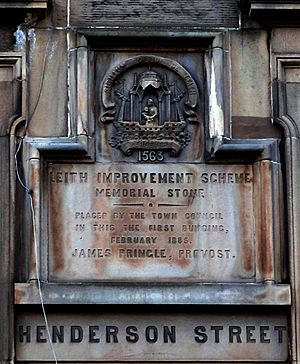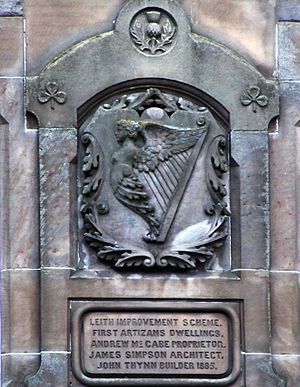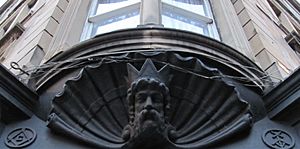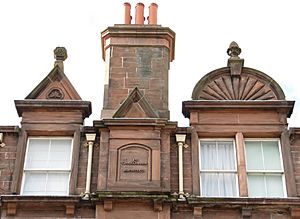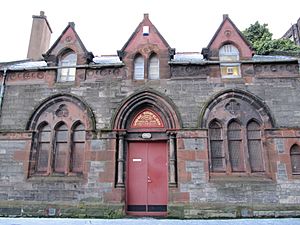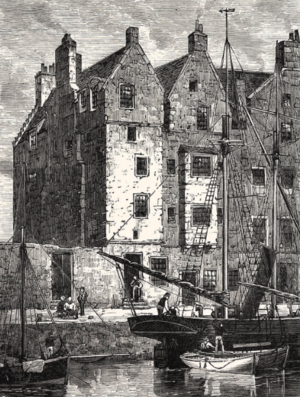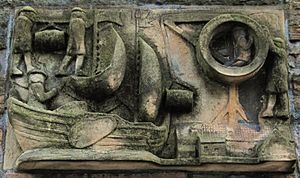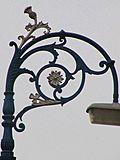Henderson Street facts for kids
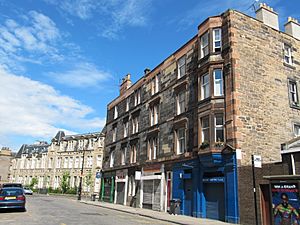
Henderson Street, Leith, Edinburgh, Scotland
|
|
| Maintained by | City of Edinburgh Council |
|---|---|
| Length | 0.4 km (0.2 mi) |
| Location | Leith, Edinburgh, Scotland |
| Postal code | EH6 |
| Coordinates | 55.973126,-3.173161 |
| North East end | Shore, Leith, Edinburgh |
| South end | Great Junction Street, Leith, Edinburgh |
| Construction | |
| Commissioned | 1880 |
| Construction start | 1886-1887 |
| Completion | 1890s |
Henderson Street is a well-known street in Leith, a lively area of Edinburgh, Scotland. It curves between Great Junction Street and an area called the Shore. This is where the Water of Leith river meets the Leith Docks. Henderson Street is part of the Leith Conservation Area, which means it has many special old buildings.
The street is named after Dr. John Henderson (1819–1901). He was a doctor and a leader in Leith, serving as Provost (like a mayor) twice. Dr. Henderson worked hard to make sure the "Leith Improvement Scheme" happened. This big project led to Henderson Street being built.
Contents
Why Henderson Street Was Built
In 1877, Dr. John Henderson and the Leith Town Council wanted to make Leith a healthier place. They noticed that many people, especially babies, were getting sick in the crowded area between Giles Street and Coalhill. This part of Leith had many old, packed buildings, some from the 1400s.
The leaders came up with a plan to clear away these old buildings. Their main goal was to connect Great Junction Street to the Shore. This would make it much easier to get to the harbor. The project removed 18 old, narrow alleys and hundreds of buildings. It was hoped that building new, better homes would improve life for everyone.
Building the Street
Henderson Street was built as part of the "Leith Improvement Scheme." This was a special law passed by the UK Parliament in 1880. To build the street, 18 old alleys had to be knocked down. At that time, many homes in Leith were very crowded and unhealthy. People hoped that Henderson Street would bring better living conditions.
The street was planned to be 50 feet wide. Most of the buildings were Victorian-style tenements, which are large apartment buildings. Many also had shops or businesses on the ground floor. Building Henderson Street took several years. Records show that new homes were still being built from the late 1880s into the 1890s.
Early Life on Henderson Street
Henderson Street first appeared in local directories in 1886/87. At first, only a few addresses were listed, showing the street was still being built. Over the next ten years, more and more homes and businesses appeared.
Early residents included people like joiners (who work with wood), contractors, midwives, sailors, and master mariners. There were also apprentice engineers, fruiterers (who sell fruit), and bakers. Businesses included drapers (who sell fabric), dairies, and even an Inland Revenue office. From 1891 to 1900, the Leith Herald newspaper was published from 12 Henderson Street. A printing company is still there today!
The street provided homes for "artisans" (skilled workers) and "labourers" (unskilled workers). These homes were usually rented. Old records from 1891 and 1901 show that many flats housed large families, sometimes with six to eight people. They might even have had a lodger or a maid living with them. These large families lived in what we would now call a comfortable two-bedroom flat.
Today, the apartments on Henderson Street are privately owned or rented. The street has a mix of people, including families who have lived in Leith for a long time and newer residents.
Victorian Buildings
Henderson Street has some beautiful examples of Victorian buildings. Many of them are "listed buildings," which means they are protected because of their historical importance.
At Number 2 Henderson Street, you can see a detailed carving of the sea god Neptune above the corner entrance. This carving probably shows how important the sea was to the Port of Leith. This building also has a stone plaque that says it was the first project of the "Leith Improvement Scheme." It was built in 1885.
James Simpson's Designs
James Simpson (1832–94) was a Scottish architect. He was the Town Architect of Leith and designed many important buildings. These include Leith Town Hall and Leith Hospital.
Simpson also designed the building on Henderson Street now called 'Academia'. It used to be St. Mary's workshops and was originally Yardheads School. Even though its main entrance is on Giles Street, the back of the building is a big part of Henderson Street. This school was built in 1875 and could hold 400 children.
Near the Shore end of Henderson Street (numbers 73-91A), there's another impressive building designed by James Simpson. It's made of sandstone with detailed carvings. It was built in 1891, and you can still see Simpson's name and the date carved into the stone.
Just off Henderson Street, on Parliament Street, is another building by Simpson. It's a Model Lodging House, built in 1893. It was meant to give cheap, clean, overnight places to stay for workers passing through the area. It still provides temporary housing today.
George Craig's Work
George Craig (1852–1928) took over from James Simpson as the architect for the Leith School Board. In 1888, Craig designed the Trafalgar Masonic Hall on St. Anthony Lane, just off Henderson Street. A time capsule was buried in the building when its foundation stone was laid! This sandstone building is still used by a Masonic Lodge. It has many Masonic symbols carved into its front.
Masonic Symbols on Henderson Street
You can see Masonic symbols on Numbers 2 and 4 Henderson Street, near the Neptune carving. There are also symbols on Number 14. These symbols show how important stonemasonry (the craft of working with stone) and freemasonry (a social group with old traditions) were in the area in the late 1800s.
Lost Buildings
In 1885, a large, fancy church called Kirkgate United Presbyterian Church was built at the Great Junction Street end of Henderson Street. It was knocked down in 1975, even though some people tried to save it. Today, the South Leith Parish Church halls stand on that spot. A small stone carving from the old church can still be seen on the new building.
Older Buildings and History Nearby
Scottish Parliament Building
One important building lost during the improvement scheme was the Scottish Parliament/Council Office. It stood on Coalhill, and its name is now only remembered in "Parliament Street." This beautiful stone building was built around 1545 for Mary of Guise and her council. It was very grand, but it was sadly removed during the replanning of the area.
Crabbies Warehouse
Just off Henderson Street is a street called Yardheads. Here, you'll find large warehouses that used to be Crabbies Warehouse. These buildings were a distillery that made a famous Scottish drink: Crabbies Green Ginger Wine. Crabbies Wine was first made in Leith in 1801. The company moved to Yardheads in the 1850s and made their wine there for over a hundred years. While Crabbies Ginger Wine is still made in Scotland today, the production at Yardheads stopped in the 1990s.
Parts of the Crabbies Warehouse buildings date back to 1825. They were once part of an older brewery. All the historic parts of Crabbies Warehouse are now protected buildings. In 2000, they were turned into apartments.
St. Anthony's Area
Today, the short streets called St. Anthony Place, St. Anthony Street, and St. Anthony Lane lead from Henderson Street to the modern Kirkgate Shopping Centre car park. These names are very old and tell us about the area's past. Long before Henderson Street was built, there was a monastery dedicated to St. Anthony here. It was called St. Anthony's Preceptory or Monastery.
Historians believe this monastery was on a large site. Its buildings were roughly where the Kirkgate car park, the Trafalgar Masonic Lodge, South Leith Parish Church Halls, and some Henderson Street apartments are now. A burial ground was found south of these buildings, towards Great Junction Street. This was confirmed when gas pipes were laid in St. Anthony Street. The monastery's gardens might have stretched all the way to the street still known as Yardheads. The monastery was badly damaged during the Siege of Leith in 1560. After the Scottish Reformation, it slowly disappeared as new buildings were built in its place.
The Vaults and The Porters Stone
If you walk down Henderson Street towards the Shore, you'll see the high stone wall of The Vaults on your right. The Vaults are very old buildings that have been around for centuries. They have always been connected to the wine and spirit trade, which was very important for the port of Leith. Today, The Vaults are home to the Scotch Malt Whisky Society.
When Henderson Street was built in the late 1800s, it cut through the land of The Vaults, making their yards smaller. The stone wall you see today was built around that time.
On Henderson Street, about halfway along this wall, there's a stone tablet called the Porters Stone. It's a copy of an original carving from 1678. It shows how wine was unloaded and moved through Leith back then, with the Porters of Leith at work. The original Porters Stone was in Tolbooth Wynd, an old street that led to Leith's Kirkgate. The Porters were a trade guild, a powerful group of workers in Leith's past.
The copy of the stone you see today was carved in 1990. The original was too fragile to be put back and is now kept in the Museum of Edinburgh.
Green Space
Henderson Gardens Park
Henderson Street has a small park called Henderson Gardens Park. It was created in the 1950s after some old buildings were knocked down. The park was updated in 1983 and has a plaque to remember this. It has a small play area for children, grass, seating, and is surrounded by shrubs and trees.
Street Features
Police Box
Henderson Street is home to one of Edinburgh's famous police boxes. These small police stations were designed in the 1930s.
Street Lighting
Some original Victorian cast iron street lamps are still used on Henderson Street today. These lamps are special to Leith. They have the word 'Persevere' and an image of a woman and child in a ship with the Latin words 'Sigillum Oppidi De Leith' (which means 'Seal of the Town of Leith'). The lamp heads also have designs of a thistle (for Scotland), a shamrock (for Ireland), and a tudor rose (for England). These lamps were made by Mc Dowall, Steven & Co. in Glasgow.
Fun Facts
Television and Film
Henderson Street has been a filming location! Scenes for the 2007 TV show Wedding Belles were filmed here. The writer of the show, Irvine Welsh, grew up in Leith.
Henderson Street even had its own cinema once, called the 'Empire Picture House'. It was active in the late 1920s and early 1930s. Today, a Swedish bar on the street sometimes hosts film nights, keeping the cinema tradition alive!
Businesses Today
Henderson Street still has a mix of homes and businesses. Many ground-floor shops have become homes, but there are still many restaurants and cafes.
Mitchells Café and Take Away used to be at Numbers 21-23. It claimed to be the oldest cafe in Leith, operating since at least 1924 as an Italian ice cream parlor. Many locals still called it Lannys, after its original owner. The cafe closed in 2020. Across the street, Steel Coulson Tap is a new craft beer bar.
Italian Influence
Many Italians moved to Scotland in the late 1800s and early 1900s, and many settled in Leith. Henderson Street had several Italian businesses, like Angelo Lanny's ice cream shop, Joe De Ponio's fish and chip shop, and Galletta's Italian Barbers.
During World War II, when Benito Mussolini (Italy's leader) sided with Adolf Hitler, some Italian businesses in Leith were attacked. Many Italian men, like Angelo Lanny and Joe Di Ponio, were sent away to special camps. Some even lost family members when a ship carrying Italian and German people was sunk by a German submarine. These events left a deep impression on those who remembered them.
International Flavors
Henderson Street still shows Leith's diverse population and love for international food. An Indian restaurant replaced an old Italian fish and chip shop, and there's also a Chinese restaurant. One of Henderson Street's oldest bars, The Bay Horse, has also changed over time. It was once run by a Russian Countess and is now Sofi's, a Swedish-themed bar with Swedish owners.
Fine Dining
Leith and the Shore area are now known for their excellent restaurants. Behind the wall of The Vaults, there's a well-known restaurant that is part of The Scotch Malt Whisky Society. A vegan restaurant called 'Harmonium' has also recently opened on Henderson Street.
Leith has even earned Michelin Stars for its restaurants in recent years. Plumed Horse, which opened in 2007, received a Michelin Star in 2009.
Images for kids


